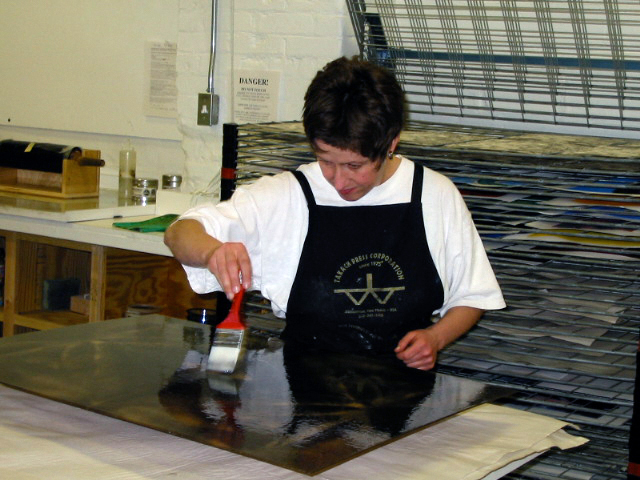Born 1963, Stuttgart, Germany
The erudite printmaker Linda Schwarz finds her subjects in remote manuscripts and centuries-old art, then uses experimental maneuvers to “bring lost and forgotten knowledge into today,” she says.1 Often she begins with an overlooked fragment of text or music that she researches with the determination of a Nobel laureate. Struck by the rhythm of the letters in a square-shaped poem by the monk Rabanus Maurus Magnentius (780/81–856 ce), she made her “Crosswords” prints (2007), whose rows conceal the names of U.S. waterways. For a 2002 series on the Romantic German poet Novalis (1772–1801), Schwarz printed from dried noodles in packets of alphabet soup. Art historian Susan Tallman has described such efforts as a melting together of “linguistic content, visual imagery, and physical objecthood.”2 Schwarz will print on both sides of the paper, make Xeroxes of Xeroxes, and artificially age her sheets to get the effect she wants. “I see printmaking more as a language for my work, not a reproduction technique,” she says.
Before tackling the subject of Johann Sebastian Bach’s cello suites (c. 1720), Schwarz spent two years watching cellists perform. Then she repeatedly hand copied the first ’s prelude from its various extant manuscript sources—including one made by Bach’s wife, Anna Magdalena Bach—and superimposed these in etchings. Next, Schwarz wanted to examine the original handwritten scores of all six suites, housed at the Berlin State Library. Her repeated requests were rebuffed until, she says, the music library head “accepted that I will never stop calling.” One outcome was “Tintenfrass” (“Ink Damage,” 2000), forty unique prints exploring the ways iron gall ink had corroded the manuscript. The subjects of her “Gestures” prints (cat. nos. 269–270 ) are figures carved by sculptor and wood-carver Tilman Riemenschneider (c. 1460–1531), specifically the hands, which Schwarz had photographed in Würzburg, Germany. Using special pigmented inks and paper of silk and hemp (she is fanatical about high-quality materials), she did her customary layering and hand painting to infuse the photolithographs—the blessing hand of Saint Valentine, the tied hand of Saint Sebastian, the pointing hand of Christ—with time and mystery.
Schwarz’s childhood was replete with art classes and free tickets to the Stuttgart State Opera, where her neighbors worked. After attending the Freie Kunstschule Stuttgart (Free Art School Stuttgart), Schwarz studied sculpture and musicology at the prestigious Berlin University of the Arts. Familiar with the Twin Cities because she had relatives in St. Paul, Minnesota, she used a scholarship to attend the University of Minnesota (1991–92). There she took up printmaking, enchanted by an approach less rule-bound than what she had experienced in Germany. She became protégé and assistant to professor Karl Bethke, also from Germany. After receiving her Berlin diploma (1993), Schwarz interned at Universal Limited Art Editions (ULAE) in New York. Popular as a visiting artist and teacher at universities in the United States and Germany, she has exhibited in both countries, including in Berlin, Munich, Stuttgart, Leipzig, Karlsruhe, Mönchengladbach, Kassel, and Würzburg. Schwarz and her family live in a sixteenth-century castle in Triefenstein, along with her 250-year-old printing press.
—Marla J. Kinney
